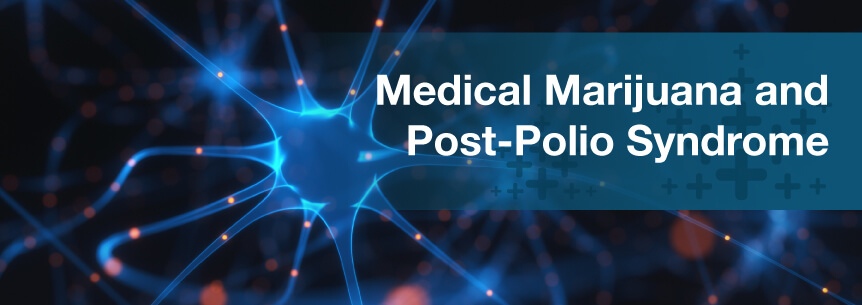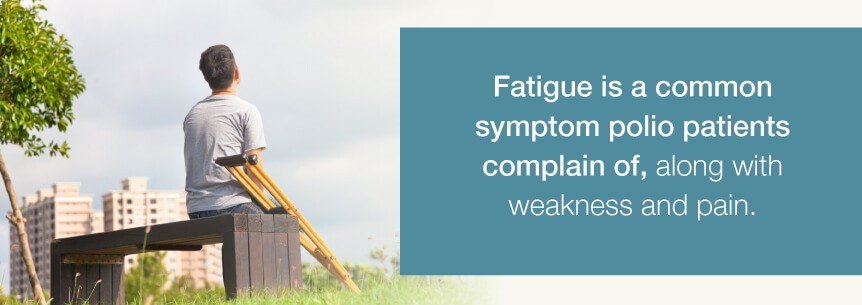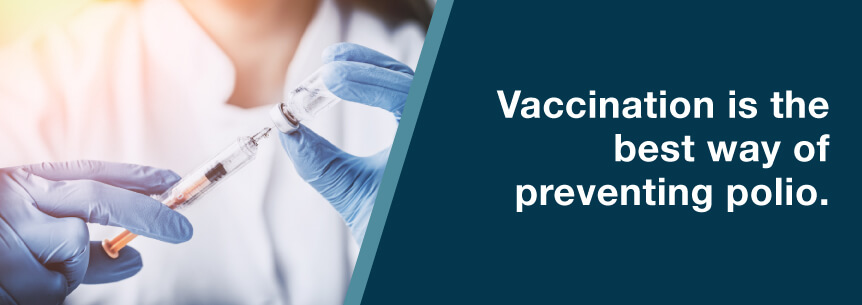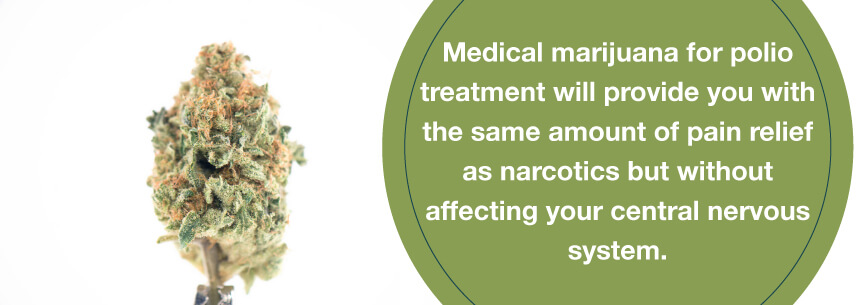
People have been using medical marijuana as medicine for a very long time. Patients using the herb find tremendous relief from a whole range of unpleasant symptoms, from chronic pain and severe nausea to inflammation and sleep problems and disorders. Now, patients can use cannabis for post-polio syndrome to find relief from its symptoms too.
Polio is an infectious disease caused by a virus. An infected person has the virus living in their throat and intestines. It’s usually spread when someone comes in contact with an infected person’s stool. If the infected person coughs or sneezes, you can become infected from the droplets. The infection can contaminate water and food as well when people don’t wash their hands.
Some individuals become paralyzed. Once paralyzed from polio, there’s no treatment to reverse it.
Some individuals with polio develop post-polio syndrome (PPS) years later. It is rarely a life-threatening condition, but its symptoms can impact your quality of life and everyday independent functioning. PPS symptoms include:
When the symptoms first present, it typically begins with muscle weakness in the areas that were originally impacted by the polio infection. Post-polio syndrome is a nervous system condition you can develop 15 to 50 years after someone is infected with polio. The condition affects your nerves and muscles, causing you to experience:
Even though the illness often makes daily activities more challenging, you can usually control your symptoms with treatment to keep you staying active. Post-polio syndrome is a gradual progression, and your symptoms might not be bad for several years. In some cases, it can cause difficulties in breathing and sleeping if there is respiratory muscle weakness. If you develop weakness in your swallowing muscles, it can lead to you aspirating food into your lungs or developing pneumonia.
You can only develop post-polio syndrome if you’ve had polio. However, you won’t necessarily get polio again if you have post-polio syndrome. The condition also doesn’t spread between people as polio does. In the U.S. and most other countries, the vaccine for polio has wiped the disease out. Post-polio syndrome is not contagious, and only survivors of polio can develop it.
While nobody knows for sure what causes post-polio syndrome, there are a few theories.
When you get the polio infection, it affects your motor neurons (nerve cells), especially the ones located in your spinal cord that deliver electrical impulses or messages between your muscles and brain. There are three basic components of each neuron:
The polio infection typically destroys or damages a lot of these motor neurons. The neurons that remain grow new fibers while the surviving motor units get larger.
This process helps you recover muscle use, and it works as a driving force pushing your nerve cell body to provide nourishment to the extra fibers. This stress, over the years, might be more to handle than the neuron can take, which can result in the growing fibers and neurons gradually deteriorating.
Some other common names for post-polio syndrome include:
The U.S, from the early parts of the 20th century through the 1960s, has seen polio epidemics affect a lot of people. Vaccines for polio just about eliminated the disease in the U.S. as well as in many of the world’s developed nations. However, U.S. individuals and other people around the world infected with the virus before the creation of the vaccines may develop post-polio syndrome.
The diagnosis criteria for post-polio syndrome over the past 20 years have evolved. Diagnostic criteria include:
Another symptom is the slow onset of persistent and progressive abnormal muscle fatigability or new muscle weakness with or without:
Onset can often appear suddenly and follow surgery, trauma or a period of inactivity. New issues with swallowing or breathing are less common but may occur due to PPS. Symptoms must last a minimum of a year and exclude other medical, orthopedic and neuromuscular issues as symptom causes.
With post-polio syndrome, you’ll experience a cluster of debilitating symptoms affecting you years after you have polio. These symptoms include:
Consult with your physician before you travel to any area of the world where there is still naturally occurring polio or where people still use the oral polio vaccine (OPV), such as Africa, South and Central America and Asia. They may recommend you get a polio vaccination.
A small number of people who have polio will also develop more severe symptoms affecting the spinal cord and brain, such as:
The most serious polio symptom is paralysis since it may result in permanent disability or even death.Out of 100 individuals with polio-related paralysis, between two and 10 die because polio affects their breathing muscles.
Fatigue is a common symptom polio patients complain of, along with weakness and pain. Fatigue can also indicate depression. Depression can vary in its symptoms, form and severity. Common symptoms include:

Bipolar depression comes with both depressive and manic characteristics. All these symptoms may impair your health, functioning, financial stability and relationships and negatively affect your loved ones’ lives.
Being able to recognize and treat depression in polio survivors is imperative since depressive symptoms like sleep disturbances and fatigue will aggravate symptoms of polio’s late effects. According to one study, none of the survivors of polio with depressive disorders were taking antidepressant medication or were in counseling. Prognosis studies show that you can treat this depression, and the best improvements come from a pharmacology and psychotherapy combination.
According to the Centers for Disease Control and Prevention (CDC):
The best medicine is prevention. Good hygiene and consistently washing your hands are best for avoiding contracting the condition. Increase calcium in your diet, and avoid sugar. Quarantine any individual suspected of being infected.
Vaccination is the best way of preventing polio. Most kids in the U.S. receive four shots of the inactivated poliovirus vaccine (IPV). They receive a dose:

Individuals with weakened immune systems can receive IPV safely. However, how protective it is in people with severe immune deficiency is not known. Redness and pain at the injection site are the common side effects of the vaccine.
U.S. adults don’t receive the polio vaccine routinely since they’re likely already immune and have minimal risk of contracting the disease. But, those with a high risk of the disease who have already had their original IPV or OPV vaccination series should get a single IPV booster shot.
One IPV booster dose will last a lifetime. Adults who are at risk are those who travel to countries where polio still exists or individuals taking care of people with polio.
If you have an undocumented vaccination status or are not vaccinated, you should get a primary polio vaccination shot series. It will be two IPV doses at intervals of four to eight weeks, and then your third dose will be six months to one year after your second dose.
Energy conservation is a standard practice in treatment where you rest frequently and pace your physical activity to reduce fatigue. Devices like a walker, cane, motor scooter or wheelchair can assist you in conserving energy. A raised toilet or shower grab bar can also help. In addition, a therapist can offer you advice on how to breathe effectively to conserve energy.
Doctors focus on making you as comfortable as possible, preventing complications and speeding up your recovery. Your doctor may prescribe:
Contact your doctor if you’ve just gotten back from traveling abroad or if you begin experiencing any of the symptoms like those of post-polio syndrome.
You can do other things to help you manage your PPS symptoms too:

Medical cannabis could help you if you’re suffering from post-polio syndrome and are experiencing symptoms of fatigue and pain that go along with the syndrome. Unfortunately, if your symptoms are severe, you may end up living with substantial pain every day.
While narcotic painkillers help with the pain, they’re often contraindicated for post-polio syndrome patients because they can cause problems with breathing and slow your central nervous system down.

And, since you already have a high risk of developing breathing problems because of post-polio syndrome, it’s too much of a risk for doctors to prescribe you narcotics. Medical marijuana for polio treatment, however, will provide you with the same amount of pain relief as narcotics but without affecting your central nervous system.
Medical marijuana for polio can help treat polio symptoms such as:
Medical pot can help patients with polio because its cannabinoids are:
Strains of medical cannabis for polio are plentiful. They each have their healing properties to tackle many of the symptoms of polio. Some good strains you’ll want to try to relieve your symptoms include:
Strains for Pain
Strains for Fatigue
Strains for Sleep
Strains for Nausea and Vomiting
Strains for Depression and Anxiety
Cannabis methods vary. For instance, if you’re looking to medicate discreetly and/or need long-lasting effects, you may want to try patches, edibles or tinctures. Those who can’t tolerate the THC in medical weed can try micro-dosed products rich in CBD. If your pain is more localized, transdermal patches and balms are ideal.
If you’re ready to take the next step and would like to try marijuana for polio, visit us at MarijuanaDoctors.com to find a cannabis doctor and book your appointment online. All doctors are qualified to help you with your medical cannabis needs. Then, you can search for your favorite strains and products through our large database of marijuana dispensaries.
Find A Doctor Find A Dispensary